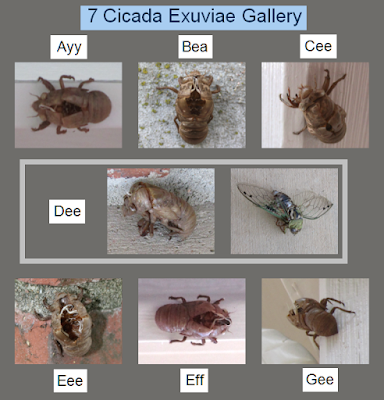| Date | Name | Comment |
|---|---|---|
| July 11 | Ayy | Upside down at the porch overhang, seemingly to hug it symmetrically while defying gravity—no "glue" involved. |
| July 21 | Bea | At a vertical part of the porch, head toward the sky. (One pic, taken with the flash on, resulted in a coppertone face-like image.) |
| July 24, 25 | Cee | Initially at a porch column corner, head angled skyward; July 25 pix shows profile and belly-up views (porch surface). Definitely see no "glue" residue. |
| July 27 | Dee | At porch surface and brick wall intersection, but also featuring the cicada itself on porch surface. |
| July 31, Aug 1 | Eee | At a brick wall edge, head skyward, with nearby ant and spider. |
| Aug 1 | Eff | Upside down at porch overhang, similar to exuviae Ayy. |
| Aug 1 | Gee | Similarly positioned as exuviae Cee, but at a different porch and near the overhang. |
My first exposure to cicada exuviae, was in 2016, when I posted a pic (a beaut!) to LinkedIn requesting ID help. Shortly thereafter, I posted "Closeup of Molted Cicada Exoskeleton (and More Info)". A cicada exuviae (exoskeleton), imho, is fascinating for its split-back opening that displays much of the inside of the abandoned shell and inside-out "appendages". View a great, 34-second time-lapse video of a cicada emerging and vacating its shell.
One commonality of most exuviae I've spotted was the skyward position of the head. For some other exuviae, I thought it odd that they hung upside down parallel to the ground. I wondered if cicada nymphs applied some type of glue before attempting self-extraction. "Photo Essay: Cicada Nymph Molts into Adult" explains cicada nymphs' strategy for attaching their exoskeletons onto something before shellbreak:
they find a place on a tree to grab hold and ‘affix’ themselves … Beginning around dusk the Cicada nymph crawls out of the ground and up a tree to affix itself to a sturdy part. This nymph circled this branch, feeling for a strong hold. Molting is quite a process and they’ll be there awhile, so they want to make sure not to fall during the process.Note a pic on its website and accompanying caption: "a cicada attached itself to another cicada nymph who was about to emerge."
"Bug of the Week: Cicada Nymph" complements the Photo Essay site for emphasis on the nymph stage. It also might shed light about those "appendages" I mentioned earlier.
In the back where the skin has split you can often see tiny white threads. Those are the reminants [sic] of the cicadas breathing tubes, called trachae.My most fascinating cicada/exuviae experience was spotting a cicada emerging from its exoskeleton—"Molting Cicada Visitor at My Doorstep". It was a periodic monitoring of pic-taking and videorecording that spanned several hours. (So proud of the video I created!)
For more articles about cicadas, enter "cicada" in the search box at the upper left of this window. Or find and click "cicada" link at Partial Index of Keywords section (just below Popular Posts section).


2 comments:
Very interesting and nice investigative/technical writing. You're a natural!
Thx for good words! I've had a bit of help from co-observer. Also, the cicada nymphs helped by parking themselves to become feature subjects. I'd poked around my files and found that a few years ago, some other exuviae had hung upside down at the porch overhang, like Ayy and Eff.
Post a Comment